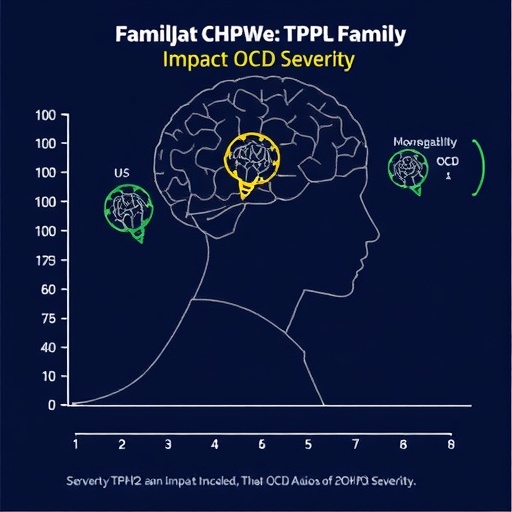In a groundbreaking study published in BMC Psychiatry, researchers have unveiled a complex interplay between genetic regulation and environmental factors in driving the severity of obsessive-compulsive disorder (OCD). This investigation specifically illuminates how DNA methylation in the promoter region of the Tryptophan Hydroxylase 2 (TPH2) gene and familial influences, including parenting styles and family functioning, converge to shape OCD pathology. The findings could mark a pivotal advancement in unraveling the elusive biochemical and psychosocial mechanisms that underpin OCD, offering promising trajectories for personalized therapeutic approaches.
OCD, characterized by intrusive thoughts and repetitive behaviors, is widely recognized as a multifactorial disorder, with both genetic predispositions and environmental stimuli playing critical roles. Previous studies have implicated the serotonin biosynthesis pathway, particularly the TPH2 gene, which codes for the rate-limiting enzyme in serotonin production within the brain. Serotonin’s influence on mood and behavior is well documented, but this investigation sheds light on epigenetic modifications—specifically DNA methylation—that alter TPH2 expression, potentially modulating serotonin synthesis in ways that exacerbate OCD symptoms.
To dissect this gene-environment interrelationship, the research team recruited 58 individuals diagnosed with OCD alongside 89 age- and gender-matched healthy control subjects. Employing the highly sensitive MassARRAY system, methylation levels at 12 CpG sites—regions where methyl groups attach to DNA to regulate gene expression—within the TPH2 promoter were quantified. Such granularity enabled the researchers to detect subtle but statistically significant differences in methylation patterns correlated with both OCD presence and symptom severity.
One of the remarkable findings was the identification of CpG site 6 methylation as a robust biomarker linked with OCD diagnosis, maintaining significance even after rigorous Bonferroni correction for multiple comparisons. This indicates that hyper- or hypomethylation at this locus may materially influence TPH2 gene activity, thereby modifying serotonin availability in neural circuits implicated in OCD. This insight invites further exploration into specific epigenetic targets for pharmacological intervention aimed at normalizing serotonin levels.
Beyond molecular data, the study innovatively integrated evaluations of the family environment using validated psychometric tools: the Family Assessment Device (FAD) and the Egna Minnen Barndoms Uppfostran (EMBU) questionnaire. The former assesses dimensions of family functioning such as communication, roles, and emotional involvement, while the latter explores retrospective perceptions of parenting styles, including dimensions like punishment and parental preference. These assessments allowed the researchers to correlate familial context with epigenetic markers and clinical measures of OCD severity.
Intriguingly, methylation levels at CpG sites 2 and 1/3/8 demonstrated inverse relationships with the ‘general functioning’ and ‘roles’ subscales of the FAD respectively, reflecting that poorer family dynamics may be associated with decreased methylation at these sites. Conversely, CpG site 7 methylation positively correlated with ‘affective involvement’, suggesting that nuanced aspects of emotional engagement within the family environment might influence epigenetic modulation differentially across the TPH2 promoter.
Moreover, the presence or absence of specific parenting styles detected via EMBU corresponded with significant differences in methylation at several CpG sites (2, 4, 5, 9, and 10). These observations imply that early life environmental inputs, perhaps related to parental control or warmth, could leave lasting epigenetic imprints that alter gene regulation patterns relevant to OCD risk. Such evidence supports the notion of epigenetic plasticity shaped by childhood experiences, contributing to the disorder’s heterogeneity.
Symptom severity, measured objectively by the Yale-Brown Obsessive Compulsive Scale (Y-BOCS), was also linked to epigenetic and familial variables. Elevated methylation at CpG sites 6, 9, and 12 was associated with higher Y-BOCS scores, reinforcing the functional impact of these epigenetic marks on clinical expression. Importantly, several dimensions of family functioning (problem-solving, communication, affective responsiveness, and general functioning) alongside paternal punitive behavior and maternal preference bore significant correlations with OCD severity, emphasizing the influential role of family milieu.
These findings collectively suggest a gene–environment interaction model wherein adverse family environments could mediate OCD vulnerability through epigenetic regulation of the TPH2 gene and subsequent disruption of serotonergic pathways. Such a model provides a compelling framework integrating biological, psychological, and social domains, encouraging multifaceted treatment strategies that address both neurobiological and environmental contributors to OCD.
The implications for future research are profound. Understanding how environmental stressors translate to epigenetic modifications opens avenues for preventative interventions in at-risk populations, potentially via psychosocial support or epigenetic therapeutics. Furthermore, these results advocate for incorporating familial assessments into clinical practice to better tailor interventions that acknowledge the patient’s contextual background alongside their molecular profile.
As the field of psychiatric epigenetics evolves, this study exemplifies the power of combining cutting-edge molecular biology with comprehensive clinical and psychosocial evaluations. The nuanced correlations between TPH2 methylation and family dynamics highlight that individual susceptibility to OCD may hinge not solely on fixed genetic inheritance but also on modifiable environmental exposures and their biological echoes.
In conclusion, this research pioneers a holistic perspective on OCD pathogenesis by elucidating how DNA methylation of the TPH2 gene and family functioning collaboratively influence symptom severity. By bridging molecular genetics and family psychology, it charts a promising path toward personalized medicine in psychiatry, where therapeutic decisions could be informed by the interplay between one’s epigenome and psychosocial context. This integrative approach holds transformative potential for improving outcomes for millions afflicted by OCD worldwide.
Subject of Research: The study investigates the combined effects of TPH2 gene DNA methylation and family environment factors, including parenting styles and family functioning, on the etiology and symptom severity of obsessive-compulsive disorder (OCD).
Article Title: Influence of TPH2 DNA methylation and family functioning, parenting styles on OCD severity
Article References:
Wang, L., Chen, Y., Hu, S. et al. Influence of TPH2 DNA methylation and family functioning, parenting styles on OCD severity. BMC Psychiatry 25, 882 (2025). https://doi.org/10.1186/s12888-025-07217-0
Image Credits: AI Generated




